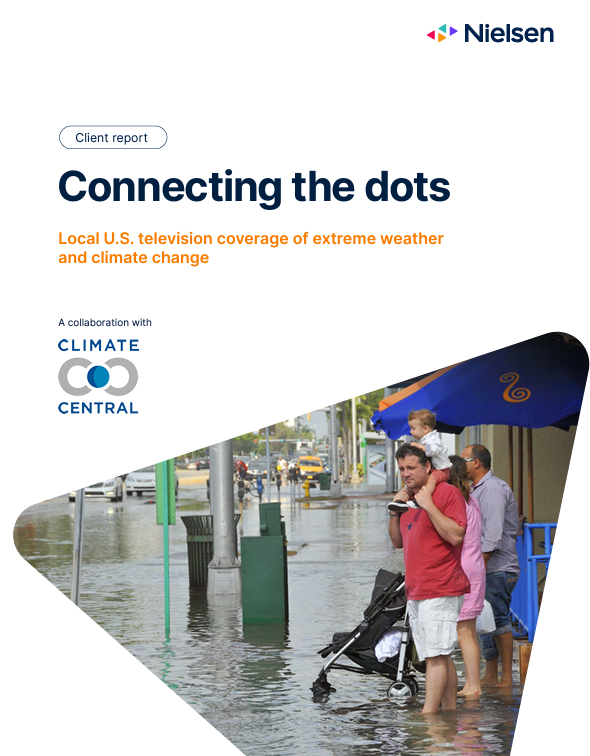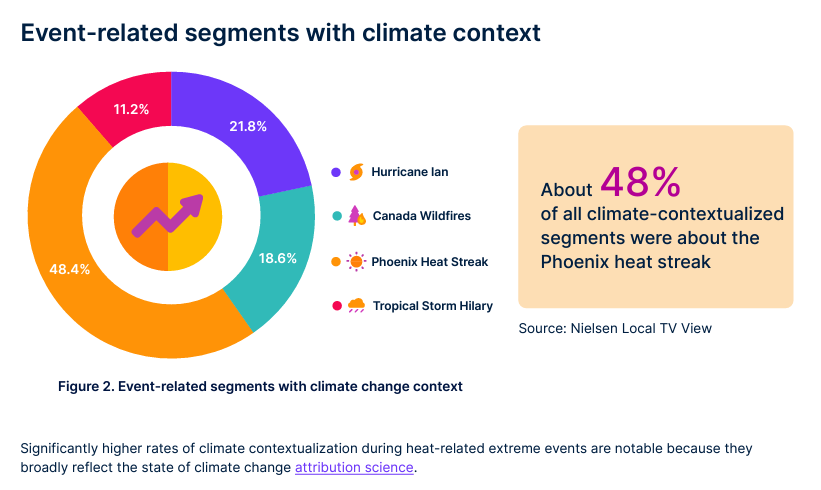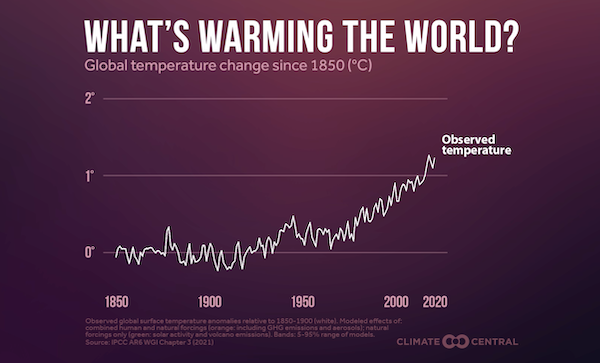Climate Central and Nielsen Release Climate Report: Connecting the Dots
Local U.S. television coverage of extreme weather and climate change
Originally published on Climate Central
A new report from Nielsen and Climate Central explores how and when local television news discussed climate change when covering recent extreme weather events. This report yields insight into whether and how local television broadcasts in the U.S. connect the dots between climate change and extreme weather events as they occur. The results indicate that such coverage: reaches large and widespread public audiences; is most prevalent for heat-related extreme events; highlights specific hazardous impacts from climate-linked events; and rapidly incorporates the findings from event-specific attribution analysis to better inform audiences.
In a warming world with extreme weather events rising in frequency and/or intensity, local media has increasingly critical roles in both preparing audiences for near-term hazards and informing audiences about how our warming climate is driving long-term changes in extreme events.
This collaborative report by Nielsen and Climate Central quantifies the frequency and audience reach of local television news segments that provided climate change context in their coverage of four notable extreme weather events in the United States. Nielsen provided audience and closed captioning data and insights about local news audiences. Climate Central’s expertise in climate science and communication were applied in data analysis, interpretation, report drafting, and data visualization.
KEY CONCEPTS
- Most adults in the U.S. (72%) are convinced that global warming is happening, yet only 58% understand that human activities are the main cause.
- Local news is uniquely positioned to fill these knowledge gaps and inform the public on the causes and consequences of climate change — especially during extreme weather events.
- A new report from Nielsen and Climate Central analyzed four recent extreme weather events in the U.S. to understand when and how local television news coverage discussed climate change.
- Audiences surged during these events. Related coverage that discussed climate change reached over 17 million people across the 50 largest U.S. media markets.
- Attribution science was also reflected in television coverage, informing local audiences about the influence of human-caused climate change on extreme weather events as they unfold.
- A roundup of science-based reporting resources can help bring climate change context into a range of stories.
KEY FINDINGS
According to research published by the American Meteorological Society, local weather broadcasting is extremely effective in raising awareness about climate change Feygina et al., 2020. This report analyzed local television news coverage of four recent extreme weather events that had notable impacts in the U.S. to understand when and how event-related coverage discussed climate change. The five key findings are:
- When television segments with climate change context occur, they have high reach and impact. Although just 5% of event-related segments provided climate change context those segments collectively reached more than 17 million people across the 50 largest U.S. media markets. Even when they occur at relatively low frequency, television segments that provide climate change context during extreme weather events have a large and widespread impact.
- Audiences surged during extreme weather events. Local television news audiences grew dramatically in the most directly impacted media markets as extreme events unfolded, likely due to the breaking news nature of these events and the immediate threats they posed to public safety. Most notably, local television audiences doubled in Orlando (Hurricane Ian) and increased 78% in Los Angeles (Tropical Storm Hilary) compared to the week prior to each event. As extreme events occur, the public turns to local television broadcasts to stay prepared and informed.
- Extreme heat was connected to climate change most often, reflecting the state of the science. The extreme July 2023 heat streak in Phoenix accounted for almost half (48%) of all climate-contextualized segments across all four events. Significantly higher rates of climate contextualization during extreme heat events are notable because they broadly reflect the state of the science. Scientific confidence in the attribution of extreme heat to human-induced climate change is considerably higher than for any other type of extreme weather event.
- Climate-contextualized segments highlight hazardous impacts. An analysis of closed captioning text from contextualized segments found communicating the hazardous impacts extreme weather has on local communities was key. While all segments mentioned at least one event-related impact, nearly all (96%) climate-contextualized segments mentioned at least one major impact that fell into one of five categories: health and safety, vulnerable communities, power supply and demand, the economy, and travel disruption. The most frequently mentioned impacts were related to health and safety—consistent with the acute risks faced during extreme weather events. Contextualized segments on Canadian wildfires in June 2023 had the highest rate of health and safety mentions, reflecting the serious and widespread health risks from exposure to wildfire smoke.
- Local news is a critical lever for raising science-based awareness about climate change. Local newscasters, particularly broadcast meteorologists, have daily contact with the American public. They can inform audiences about how specific weather events are connected to rising temperatures and climate change. As extreme weather increases with climate change, viewers overwhelmingly turn to local news for answers. For example, during Hurricane Ian, local news streaming apps in Orlando saw increases of over 244% for persons aged 2 and up and 395% for persons aged 25-54. Local broadcasters play a crucial role in keeping the public safe and empowering people to make informed decisions.
Read the report here and find Climate Central Climate Reporting resources here.






